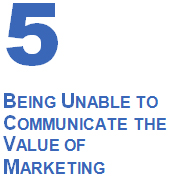Analytical Marketing
Section 1 – The Challenges
By David Bartenwerfer
Marketing is a discipline undergoing a dramatic transformation. Today’s Marketers not only have to navigate a new digital world that has changed the way consumers interact with brands, they also must embrace that this digitization produces data, lots of it.
In fact, Marketing is the function most impacted by the rise of data — and the most frequent gatherer of customer data — and is thus in an excellent position to take the lead. Marketing organizations must become ones that capture, integrate and analyze data. This represents both a challenge and an opportunity for marketing organizations, because if they can succeed, if they can become data-driven, if they can employ data, process, and analytics to better allocate their resources, they can create a sustainable competitive advantage. And if they don’t, the opportunity cost of not pursuing a data-driven strategy will continue to put companies at a competitive disadvantage.
The creative aspect of marketing will never go away, but now Marketers are challenged to develop a competency around quantitative analysis while meeting conventional marketing demands.
IMPACT ON CUSTOMER RELATIONSHIPS
With increasing digitalization comes increasing personalization of consumers’ relationships with brands—and those relationships no longer end after purchase. As a result, Marketing organizations must adapt by optimizing their resources across the new spectrum of marketing objectives. This can only be accomplished by capturing, integrating, and employing data: data about customers, prospects, products, supply chain, partners, geographies, markets, competitors, from sources both internal and external. Marketers must capture data (through process), make data usable, and then employ that data (analytics) — companies that do this will improve. These companies will better understand the trigger points that cause customers to defect, and thus have higher retention rates. These companies will understand what drives new customers to their products, and thus acquire new customers more efficiently.
These companies will better understand the impact of their investments, and thus will get more out of their investments. These companies will understand the profitability of their customers and products, and thus be better positioned to improve their profitability. In short, companies that leverage data will gain a competitive advantage.
The bottom line: The game has changed from out-doing your competition to out-thinking them.
WHAT IS ANALYTICAL MARKETING
Analytical marketing is collecting and deriving insights from all data in order to drive current or prospective customer engagement and improve the results of marketing investments. Analytics enable marketers to become more effective in planning, executing, and, most importantly, proving the value of marketing, thus increasing returns on marketing investment.
Taking a more analytical approach to marketing starts with a better understanding of the customer experience. The customer experience is the sum of digital and physical interactions across the enterprise. Every time someone engages digitally in any capacity, and physically in most capacities, they leave a trail of digital information. This data, viewed holistically, creates a reflection of how consumers spend their time, what is important to them, what they like, even what they want. Add all these external digital inputs coupled with the financial, marketing, service, and demographic information already trapped within the enterprise, and you get a large opportunity to leverage that data for competitive advantage. Analytical marketing is made possible by the flood of digital data being generated across devices and the web.
There are many quantitative tools currently available to marketers which, when coupled with the right metrics, can give executives the tools they need to make better decisions, drive revenue and competitive advantage — this is called Marketing Analytics. This series of articles offers a roadmap to achieving a more analytically-focused marketing department. One that uses the right technology, makes the right data available, employs the right processes, produces the right metrics and generates insights that continually enable the organization to learn and challenge existing assumptions in an ever-shifting competitive and customer-centric landscape.
FIVE CAUSES OF CURRENT CHALLENGES
The application of analytics to marketing requires collecting, analyzing, and executing on insights derived from data across the enterprise and beyond in order to drive engagement with current and prospective customers. Data and analytics are the engine behind the promise of improved marketing results. And, coupled with the right metrics, creates accountability as marketers become more effective in planning, executing, and proving the value of their efforts.
There are several reasons why marketing organizations fail to get value from their analytics efforts. In many instances, marketers are unable to clear one (or more) of five hurdles: being too tactical, being too manual, being too silo-ed, a lack of talent and training, and being unable to communicate the value of marketing to the rest of the organization.

In some cases, marketing gets trapped into being a purely tactical function, too focused on supporting Sales with lead generation and sales tools. In other instances, Marketers’ primary deliverables are websites and PowerPoint slides/templates. In contrast, forward-thinking companies leverage the marketing function in a more evolved and strategic role. Here, Marketing drives the product (or service) roadmap, understands the customers’ purchase journey, and essentially leads the business.
To earn that strategic role, marketers must embrace data and be analytical enough to glean insights from that data to inform decisions. These firms recognize that marketing is a new strategic opportunity and realize it can be the foundation for the success of the entire company because when Marketing shifts from the tactical to the strategic, they’re empowered to become customer-centric. Guided by a customer-centric focus, they can direct the course of innovation and enable the change necessary to compete in today’s global, and increasingly digital, marketplace.
This transformation should come naturally as marketers have always been the experts when it comes to understanding customers. The difference today is that marketers can now use analytics to link the actions meant to influence current and potential customers directly to company revenue. As a result, Marketing organizations can prove the value of their strategy to justify change across the organization.

A data silo is an insular repository of fixed data that cannot exchange content with other systems, effectively isolating information and sealing it off from the rest of the organization. Born from good intentions, data silos are increasingly facing criticism as an impediment to analytical productivity and good decision-making. The adoption of enterprise resource planning (ERP) and customer relationship management (CRM) systems in addition to customer-facing websites, undocumented Call Center conversations, and data received from other ad-hoc processes have all facilitated many independent storehouses of data within an organization.
Executives and their teams frequently wrestle with questionable data because of duplicates, invalid information or the lack of unique identifiers. They crave to capture more information and uncover more insights in order to drive more positive results, and yet, the data silos continue to grow bigger and more complex, stymieing their attempts. Data silos make it near impossible to create a holistic (360°) view of current and potential customers and perform the advanced analytics necessary to discover what influences their purchasing behavior.
Many marketers are talking about big data and analytics, but very few understand how to tackle it, and even fewer have begun the leverage it within their organizations to inform more strategic, value-based customer engagement strategies. The true value of data comes from the insights it reveals, and those insights are only made possible after data is integrated across the company, including from digital, off-line, internal, and external sources.


In some cases, marketing gets trapped into being a purely tactical function, too focused on supporting Sales with lead generation and sales tools. In other instances, Marketers’ primary deliverables are websites and PowerPoint slides/templates. In contrast, forward-thinking companies leverage the marketing function in a more evolved and strategic role. Here, Marketing drives the product (or service) roadmap, understands the customers’ purchase journey, and essentially leads the business.
To earn that strategic role, marketers must embrace data and be analytical enough to glean insights from that data to inform decisions. These firms recognize that marketing is a new strategic opportunity and realize it can be the foundation for the success of the entire company because when Marketing shifts from the tactical to the strategic, they’re empowered to become customer-centric. Guided by a customer-centric focus, they can direct the course of innovation and enable the change necessary to compete in today’s global, and increasingly digital, marketplace.
This transformation should come naturally as marketers have always been the experts when it comes to understanding customers. The difference today is that marketers can now use analytics to link the actions meant to influence current and potential customers directly to company revenue. As a result, Marketing organizations can prove the value of their strategy to justify change across the organization.

Even when automation systems and data warehouses are in place, companies can’t leverage data and analytics to drive improvements to their profitability without the expertise of data scientists and others trained in skills like quantitative analysis, predictive modeling, statistics, economics, financial modeling and the management of large data sets.
However, professionals in these areas are in short supply which means that opportunities are being lost while many companies scramble to fill the void or go without. Most companies intend to invest in analytics and big data technologies; however, a lack of human resources and corporate know-how keeps them from gaining deeper insights.
In fact, insufficient technical and analytical expertise is the most imminent challenge when it comes to getting value from data.

Even when Marketing has established an integrated and automated system for managing its programs, there will be questions in the Board Room if Marketing cannot effectively articulate its value. Rightfully so, senior management continues to apply increasing pressure to justify investments with calculated evidence — marketers are expected to objectively measure and present the ROI of their efforts. Yet, even seasoned marketers may be overwhelmed to develop a competency around quantitative analysis while meeting conventional marketing demands.
One of the major hurdles the marketing profession must overcome is the complexity of their operation. When other departments make investments, the relationship between "cause" and "effect" is usually straightforward. Increased revenues demonstrate the impact of a new product; decreased costs prove the value of new machinery. But Marketing efforts are more complex and inter-dependent rendering such a simple analysis limited and incomplete. Most experts agree that it can take between seven and nine “touches” before a customer will actually make a purchase, requiring marketing programs to overlap and work together to increase the likelihood of an eventual sale. This makes the capture, integration and intelligent use of data of paramount importance.
Marketing complexity also makes determining the individual impact of each program difficult to ascertain without robust data and more advanced analytical methods. Further, marketing programs have multiple objectives and engage prospects at different stages of their decision process. And,while individual initiatives may not be in conflict, their diverse natures make it challenging to objectively evaluate Marketing investment options. A robust and holistic ROI approach builds on the marketing funnel concept and employs analytical tools to understand the changing value of prospects as they advance through the funnel from stage to stage and program to program.
Marketers should create metrics to quantify the impact of each objective at each stage of each campaign. In so doing, they can more clearly understand the ROI of their marketing investments at both granular and holistic levels to drive more value from their efforts.
Link to the next article in the sequence: Analytical Marketing 2.0 – Five Steps
Author
David Bartenwerfer is the founder and principal of Quantum Consulting and Technology. QuantumCT helps product and marketing organizations get smarter and prove, predict and optimize impact and ROI with economic and financial modeling that employs customizable algorithms and technology leading to fast and lasting insight and action. Mr. Bartenwerfer has over twenty years’ experience in the High Tech, Internet, Telecom, Media, Financial Services and Retail industries and holds a B.S. in Systems Engineering with minors in applied mathematics and economics from the University of Virginia and an M.B.A. from the Stanford Graduate School of Business. For further information, contact the author at davidbartenwerfer@quantumct.com .